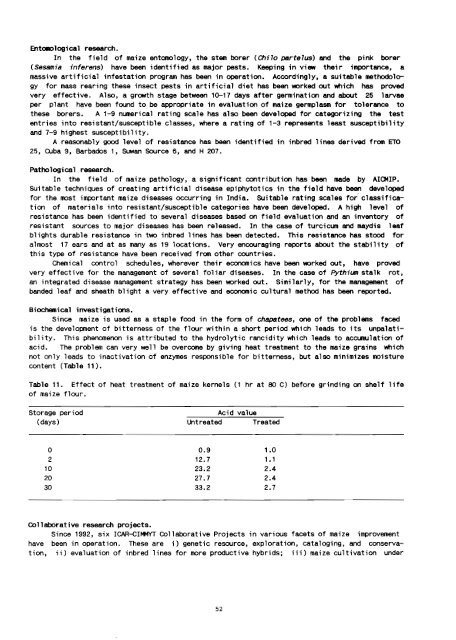Proceedings of the Fifth Asian Regional Maize Workshop - Search ...
Proceedings of the Fifth Asian Regional Maize Workshop - Search ...
Proceedings of the Fifth Asian Regional Maize Workshop - Search ...
You also want an ePaper? Increase the reach of your titles
YUMPU automatically turns print PDFs into web optimized ePapers that Google loves.
EntQllOlogical research.<br />
In <strong>the</strong> field <strong>of</strong> maize entomology, <strong>the</strong> stem borer (Chi7o parte7us) and <strong>the</strong> pink borer<br />
(Sesamia inferens) have been identified as major pests. Keeping in view <strong>the</strong>ir importance, a<br />
massive artificial infestation program has been in operation. Accordingly, a suitable methodology<br />
for mass rearing <strong>the</strong>se insect pests in artificial diet has been worked out which has proved<br />
very effective. Also, a growth stage between 10-17 days after germination and about 25 larvae<br />
per plant have been found to be appropriate in evaluation <strong>of</strong> maize germplasm for tolerance to<br />
<strong>the</strong>se borers. A 1-9 numerical rating scale has also been developed for categorizing <strong>the</strong> test<br />
entries into resistant/susceptible classes, where a rating <strong>of</strong> 1-3 represents least susceptibility<br />
and 7-9 highest susceptibility.<br />
A reasonably good level <strong>of</strong> resistance has been identified in inbred lines derived from ETO<br />
25, CUba 9, Barbados 1, SUWan Source 6, and H 207.<br />
Pathological research.<br />
In <strong>the</strong> field <strong>of</strong> maize pathology, a significant contribution has been made by AICMIP.<br />
SUitable techniques <strong>of</strong> creating artificial disease epiphytotics in <strong>the</strong> field have been developed<br />
for <strong>the</strong> most important maize diseases occurring in India. SUitable rating scales for' classification<br />
<strong>of</strong> materials into resistant/susceptible categories have been developed. A high level <strong>of</strong><br />
resistance has been identified to several diseases based on field evaluation and an inventory <strong>of</strong><br />
resistant sources to major diseases has been released. In <strong>the</strong> case <strong>of</strong> turcicum and maydis leaf<br />
blights durable resistance in two inbred lines has been detected. This resistance has stood for<br />
almost 17 ears and at as many as 19 locations. Very encouraging reports about <strong>the</strong> stability <strong>of</strong><br />
this type <strong>of</strong> resistance have been received from o<strong>the</strong>r countries.<br />
Chemical control schedules, wherever <strong>the</strong>ir economics have been worked out, have proved<br />
very effective for <strong>the</strong> management <strong>of</strong> several foliar diseases. In <strong>the</strong> case <strong>of</strong> pythium stalk rot,<br />
an integrated disease management strategy has been worked out. Similarly, for <strong>the</strong> management <strong>of</strong><br />
banded leaf and sheath blight a very effective and economic cultural method has been reported.<br />
Biochemical investigations.<br />
Since maize is used as a staple food in <strong>the</strong> form <strong>of</strong> chapatees, one <strong>of</strong> <strong>the</strong> problems faced<br />
is <strong>the</strong> development <strong>of</strong> bitterness <strong>of</strong> <strong>the</strong> flour within a short period which leads to its unpalatibility.<br />
This phenomenon is attributed to <strong>the</strong> hydrolytic rancidity which leads to accumulation <strong>of</strong><br />
acid. The problem can very well be overcome by giving heat treatment to <strong>the</strong> maize grains which<br />
not only leads to inactivation <strong>of</strong> enzymes responsible for bitterness, but also minimizes moisture<br />
content (Table 11).<br />
Table 11. Effect <strong>of</strong> heat treatment <strong>of</strong> maize kernels (1 hr at 80 C) before grinding on shelf life<br />
<strong>of</strong> maize flour.<br />
Storage period<br />
(days)<br />
Acid value<br />
Untreated Treated<br />
o<br />
2<br />
10<br />
20<br />
30<br />
0.9<br />
12.7<br />
23.2<br />
27.7<br />
33.2<br />
1.0<br />
1.1<br />
2.4<br />
2.4<br />
2.7<br />
Collaborative research projects.<br />
Since 1992, six ICAR-eIMMYT Collaborative Projects in various facets <strong>of</strong> maize improvement<br />
have been in operation. These are i) genetic resource, exploration, cataloging, and conservation,<br />
ii) evaluation <strong>of</strong> inbred lines for more productive hybrids; iii) maize cultivation under<br />
52

















